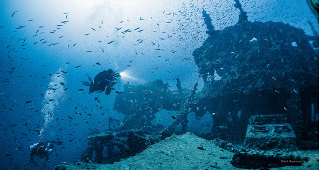
100 Years of History Rests at a Depth of 100 Meters on the Seabed
"At 100 meters depth lies ahistory of 100 years. And within aradius of two nautical miles in the waters of Kea lie two huge sunken ships anda plane that take us back in time to World Wars I and II."
The “S/S Burdigala,” discovered in 2008, is located at a depth of 70 meters. It took extensive research in archives, along with an underwater inspection, to verify its identity.
“At 100 meters depth lies a history of 100 years. And within a radius of two nautical miles in the waters of Kea lie two huge sunken ships and a plane that take us back in time to World Wars I and II. The case of the “S/S Budigala” is one of the most fascinating stories that one can “fish” in the Aegean. Built in 1897 for the German shipping company Norddeutscher Lloyd, the 183 meter long vessel was first named “S/S Kaiser Friedrich.” Together with the “Titanic’s” sister ship, the “HMHS Brittanic,” (269 meters in length), the “S/S Burdigala” was purchased by a French company. Both ships sank northwest of Kea in 1916, just 7 days apart, possibly by mines laid by German U-73 submarines. Next to the French ship there is also an aircraft from World War II.
The “Brittanic” which rests at 100-110 meters depth was discovered by Cousteau in the mid-1970s. As known, the ship – hospital was empty at the time of sinking and most of its crew members were rescued.
The “S/S Burdigala” which was carrying troops to Thessaloniki and the Dardanelles to bolster the Entente Alliance was also empty at the time of sinking and only one crew member lost his life. The ship was identified in 2008-2009 thanks to the tireless efforts of the “Kea Dive” divers. The inspection was supplemented with extensive research in foreign archives in order to establish the identity of the shipwreck.
To celebrate the Centennial Anniversary since the sinking, the Municipality of Kea together with its dynamic Mayor, Giannis Evaggelou, and the Friends of Kea Society are organizing a 3-day series of events at the end of September – early October that will give prominence to the two submerged hulls. The initiative is sponsored by the South Aegean Region and regional Prefect George Chatzimarkou. The ultimate goal is to one day create a museum for the two vessels and, above all, to promote the site as a unique diving destination for scuba diving enthusiasts, always in collaboration with the Ephorate of Underwater Antiquities and the Ministry of Culture and Sports.
While it is true that the “Brettanic” has stolen the spotlight up to now, the plight and short life of the “S/S Burdigala” is also very interesting. In its few navigational years, the “Burdigala” faced major mishaps despite that fact that at the time of its construction it stood out both for its design and its luxurious accommodations.
The reason for its construction was the unquenchable ambition of the Germans to compete with the British who, at the turn of the century and with the power of steam, dominated the trade and passenger routes linking Europe and the United States. The “S/S Kaiser Friedrich” failed to cross the Atlantic in the anticipated six days and, thus, lost the “battle.” It was laid up in the port of Hamburg for many years and later bought by the French to expedite the route between France and South America; a route it served until the outbreak of World War I when it was commissioned to transport cargo in the Mediterranean.
As Byron Riginos, President of the Friends of Kea Society, President of the Organizing Committee of the Conference and amateur diver said, it is a very impressive shipwreck. It was detected accidentally while geophysical surveys were being conducted in the region and the imagery sent back was not consistent with the geomorphology of the seabed. Based on the coordinates, an underwater inspection took place, followed by a “dive” into the archives by Dimitris Gkalon, historian diver, at which time the unfortunate outcome of the “S/S Burdigala” came to light."
Source: “Life: Culture, Sports” insert, Kathimerini newspaper, Saturday, May 21, 2016
Columnsist: Margarita Pournara
